In 2010, Amazon moved away from physical servers and opted for Amazon Web Services (AWS) cloud as a part of their DevOps for enterprise transformation. This move allowed Amazon to scale up its server capacity. Furthermore, Amazon adopted continuous integration and deployment approach by building an internal system called Apollo. Within one year, Amazon was able to deploy new software every 11.6 seconds on average. As per John Jenkins, the former lead engineer at Amazon, “The transition to enterprise DevOps is saving millions.”
NASA adopted DevOps for enterprise to leverage real-time analysis of the data points received from Mars Rover. The organization opted for containerization and continuous deployment techniques to help its scientists develop more quickly, analyze, and share their visualizations and algorithms faster.
These were two such examples where adopting enterprise DevOps proved highly advantageous. However, greater scalability, faster release cycles, improvements in code quality, greater collaboration, and communication, better risk management, etc are additional benefits of adopting DevOps for enterprises. However, it is not always a cakewalk, But, if you follow all the practices, adopting DevOps for enterprises can be less challenging. Now, let’s understand what is enterprise DevOps before going into its implementation details.
What is enterprise DevOps?
When you’re dealing with standard DevOps methodology, the focus is on creating automation in the CI/CD pipeline. It analyzes all the requirements in detail and provides meaning to each automation task. Enterprise DevOps or DevOps for enterprises is all about doing things at a larger scale in a way that promotes reliability and availability.
Another aspect of enterprise DevOps that differentiates it from standard DevOps practice is the emphasis on security. Following the standard practices of DevSecOps is paramount in DevOps for enterprises. Enterprise-level organizations need to comply with standards that promote the privacy and security of private information. You can implement enterprise DevOps for large-scale organizations that may be facing scenarios such as:
- Difficulty maintaining monolithic system or a static software
- Optimizing workflows that are primarily manual and are error-prone
- Dealing with many interdependent and related subsystems
- Ensuring compliance with security, financial, medical, or any other standard
- Following waterfall model-based processes currently among multiple teams
Benefits of enterprise DevOps
- Smooth collaboration between teams
- Improved speed and frequency of deployments
- Defect detection at the earliest stage
- High-end scalability
- Enhanced user satisfaction
- Reliability and stability of services
Implementation of DevOps allows you to speed up your development and deployment pipelines and saves a significant amount of time, effort, and cost. However, like any other methodology, DevOps also comes with its own set of challenges. For example, tracking a given task in DevOps would be pretty hard as there are multiple teams involved. Let’s explore the various other challenges related to the implementation of DevOps.
Challenges in adopting enterprise DevOps

- Communication and collaboration: Any large-scale enterprise is made up of diverse teams and sub-teams.
- Getting Dev and Ops on the same page: Developers and operations teams work separately in a traditional environment. They don’t have the psychology or the experience of working together. So, building a cohesive unit can be difficult.
- Dealing with security concerns: The lifecycle of DevOps brings security concerns with it. The reason is that DevOps promotes dividing the responsibilities and to achieve this organizations leverage containers and microservices. They share account credentials, tokens, and SSH keys on a large scale. Therefore, conducting proper change management and implementing risk mitigation strategies is paramount.
- Tool integration for DevOps: To embrace DevOps, it’s paramount that development and operations teams use the same toolset. Now, this would not be the case when different departments are involved, as different teams may prefer to use different sets of tools.
- Tech-stack incompatibility: While migrating to modern architecture, the previous tech stack consisting of older technologies becomes incompatible and inconvenient while achieving higher scalability.
Strategies for adopting enterprise DevOps
Start with a small group
It takes years of experience to build an organization’s work culture and therefore, when adopting DevOps it’s best to initiate the process with a small group and monitor how well it works. Once the results seem agreeable with a small team, you can follow the same process for other teams or groups.
Mark Schwartz, Enterprise Strategist at AWS explains its significance as “DevOps simply adds the idea that small, cross-functional teams should own the entire delivery process from concept through user feedback and production monitoring.”
Don’t fix, if it ain’t broken
It’s common for many organizations to replace their best practices to adopt popular DevOps best practices for business needs. But, it does not work well in every case. So, don’t replace what works best for you. Instead, only introduce the necessary adjustments and effectively minimize risks and increase workplace efficiency.
Improve communication
Effective communication and collaboration are critical aspects for the successful implementation of enterprise DevOps. Incorporating communication and collaboration tools will help bridge the gap between the development and operations teams. The tools used should allow operations teams to respond in real-time and communicate any underlying issue, making it simpler for development teams to improve the software and quickly deploy it for the end-users.
Hire DevOps experts
You need to hire specialists for the job if your organization is new to DevOps. A qualified DevOps engineer can help your development and operation teams to collaborate better and deliver faster. In addition, a DevOps expert will have a deep understanding of the software development lifecycle, automation, and implementation of CI/CD pipelines.
See the bigger picture
A successful DevOps strategy adoption is not restricted to development and operations teams. It suggests integrating all the members who may have a role to play in the particular software development project. For example, the legal department’s executive members play a role in licensing and contracts. So, if you could include the legal department in your DevOps ecosystem from the very beginning, they can help you comply with legal guidelines for any software development. This will eventually help you increase development productivity as you don’t have to revisit the process for a thorough legal compliance check. Holistic thinking is the way forward!
Give security its due importance
In today’s day and age, when everyone is on a hard deadline in a software development environment with limited communication, security doesn’t get its due importance. When adopting DevOps, you will be dealing with applications, containers, and microservices that share passwords and tokens between them. A poor secret management strategy that allows attackers to disrupt the operations and steal sensitive information is a common pitfall in enterprise DevOps implementation.
Leverage the right tools
Enterprises that want to implement DevOps should consider building a toolset that enables agility, collaboration, automation, communication, and compatibility as required. An appropriate toolset makes development more streamlined and allows developers to deliver faster.
Now you may understand what planning a DevOps strategy is all about, but what about its respective execution? So, in our upcoming section, we will focus on the implementation tips for DevOps on an enterprise level.
Key practices for implementing DevOps for enterprises
Enhance business confidence
DevOps causes cultural transformation and when it happens at a rapid pace, you need everyone to be on the same page. Assigning specific roles and responsibilities to all the parties involved in the DevOps lifecycle instills confidence in team members and they view themselves as an essential part of the whole transformation process. Having a defined role that specifies which team builds which part and deploys at what time builds confidence. Also, provide the team with the necessary staging environments to test while they build.
In 2015, Starbucks was busy handling 300K people on a daily basis, and handling this scale of traffic and orders in the decades-old architecture wasn’t easy. That’s when the company decided to move towards DevOps methodology. One of the core challenges that Starbucks faced during this transformation was to enhance business confidence among the various team members. That’s where the company defined the role and responsibilities of each team and made them accountable for a particular task. These tweaks within the organization were highly successful in reducing the cycle time by 74%.
Minimize operational friction
In a DevOps culture, development and operations teams need to collaborate regularly for delivering quality products at a rapid pace. However, if there is friction among both groups, you won’t be able to explore the complete potential of DevOps. By introducing real-time collaboration among various teams by introducing relevant tools, you can ensure that there is no communication gap or waste of time to mitigate a given risk. Reducing operational friction will allow organizations to automate more processes as you don’t need to consult various teams for feedback. All the communication will be in real-time and this will lead to an effective transition towards DevOps.
Etsy, an American e-commerce company, struggled with painful deployments over the years. The company’s engineering teams weren’t working well together. There was continuous operational friction among various teams and that was affecting productivity. Etsy realized that the deployment rate should be much faster than the one its teams followed. As a result, it decided to adopt the DevOps culture in 2009 and brought all the teams together.
Etsy DevOps Case Study: The Secret to 50 Plus Deploys a Day
Etsy defined specific roles and responsibilities to each team and made them accountable for their deployments. Michael Rembetsy, the former VP of Technical Operation at Etsy told Network World in 2015 that “They realized that when developers feel responsibility for deployment, they also would take responsibility for application performance, uptime, and other goals.” This approach reduced operational friction among the teams and Esty was able to deploy 60 times a day.
Setup policies and processes
Every organization has a set of policies and processes that all team members should follow for their development processes. The same goes for DevOps implementation. Standard practice is to apply policy-driven tactics for the DevOps-based model. So, start defining procedures and guidelines for information security, operations, development practices, language standards, SRE, sysops administration, and development to make DevOps adoption less complex.
Adobe Creative Cloud includes services that give users the ability to design and edit their photos using softwares such as Photoshop, Lightroom, Illustrator, etc. Initially, Adobe had adopted monolithic architecture and it facilitated point-to-point communication between various services. However, as the products grew, integration become highly challenging. Eventually, Adobe started its DevOps transformation journey and adopted microservices, containers, and CI/CD pipelines. With the Adobe Experience Platform Pipeline in play, Adobe had defined its policies and process which allowed them to make a smooth transition.
Start thinking about automation
Automation is one of the key benefits of adopting DevOps. It enables teams to function better and organizations to generate valuable metrics with ease. As an enterprise, when you’re looking to adopt DevOps, implementing automation might require a couple of tweaks in your existing processes and tools. Therefore, consider tools that encourage the implementation of CI/CD pipelines, the configuration of containerization, and orchestration for your cloud-ready apps.
In 2006, HP’s LaserJet Firmware division built various products such as printers, scanners, etc. The engineering team had over 400 developers working worldwide, but they were able to come up with only two software releases in a year. Also, the software testing team relied on manual testing which meant a waste of six weeks and after that, the result wasn’t guaranteed. As a result, HP decide to move to DevOps and started adopting techniques to promote automation. The company adopted CI/CD pipeline approach, test automation, and all the standard DevOps practices. As a result, HP made 100 to 150 code commits and 75,000 to 1,00,000 lines of code changes in a single day!
Train your teams
If you want to implement enterprise DevOps in your organization, training your teams is essential. Having adequate knowledge and experience to deal with the DevOps lifecycle makes it easier to adopt the methodology. Training teams involved enables them to understand their roles and responsibilities transparently. There are many groups, boot camps, and DevOps experts to help you prepare your teams.
As we know DevOps is not about technology adoption or following a specific development process and more about bringing people together and having one common culture or philosophy. DevOps adoption at Target started with this philosophy. The company planned out a six-week training session for their employees to understand the DevOps methodology.
According to Mike McNamara, Chief Information Officer at Target, “An essential part of Target’s DevOps strategy was the creation of an immersive, six-week session called the “Dojo,” where teams do their usual work alongside agile coaches who support them as they engage with DevOps. This has helped overcome resistance to the transition without losing productivity.”
Share progress continuously
Adopting DevOps for a large-scale organization is not easy; it requires a lot of hard work, dedication, and commitment to the cause. One way to ensure that the transition is smooth is by sharing the progress with everyone in real-time. For example, the operations teams need to provide continuous feedback to the development team about the code quality, and the development team should work towards generating output efficiently in a distributed environment. Based on those status updates, teams can plan for future actions and continuously improve the process. Also, a regular update is a milestone that keeps all the team members motivated.
Ensuring long-term commitment
Implementing DevOps for enterprises requires teams to stay focused and committed for an extended period. It is, therefore, the responsibility of the team leader to set the expectations right from day one for the development and operations teams. You can’t achieve a standardized DevOps process in a single run and learning is part of the process. Over time you understand various aspects of the DevOps lifecycle and based on the analysis, refine your pipeline.
Nordstrom, one of the leading luxury department stores, was using a development model that was focused on the waterfall approach. The big batch releases and multiple shared services were hampering the deployment and release speed. Therefore, Nordstrom decided to launch a two and half years program of DevOps transformation in 2011.
After a detailed analysis of the ecosystem, the company reduced the friction among the dev and ops teams. Working together on the same project while taking accountability for deployment was the new approach. Due to this approach, bugs reduced, throughput increased, releases became monthly from yearly. So, if you’re willing to show long-term commitment, DevOps can prove advantageous for you.
Make use of microservice architecture
For effective implementation for DevOps in an enterprise, transitioning from monolithic to microservice architecture is considered most beneficial. It allows organizations to stay agile which is the core principle of DevOps. Furthermore, this approach will enable engineering teams to develop important features autonomously. Lastly, deployment and scaling also become more accessible compared to monolithic.
Netflix started with the DVD rental business before it hosted 222 million subscribers. Like any other startup or organization, Netflix also started with a monolithic architecture. However, as the user base grew exponentially, managing such volumes of traffic and scaling the architecture to the desired demand became difficult. Netflix then adopted the DevOps philosophy and moved to an AWS-based microservice architecture. With 700+ microservices managed by various teams, Netflix ensured faster deployments and releases.
Case Study: How Netflix Became A Master of DevOps?
Key principles for implementing enterprise DevOps at scale
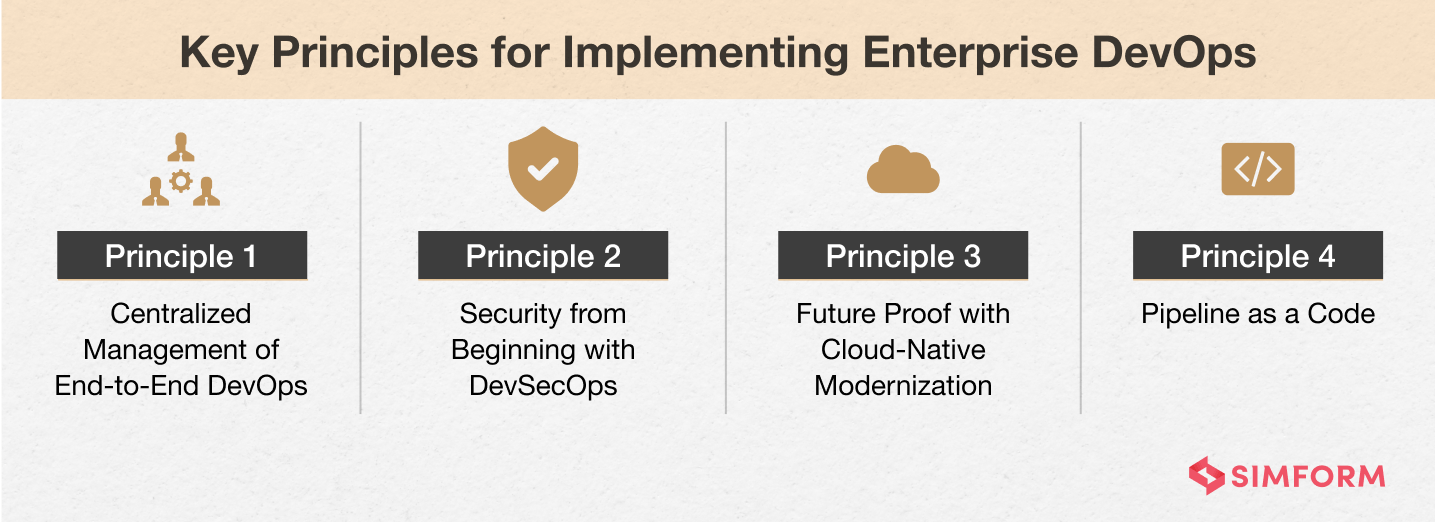
Principle 1: Centralized end-to-end management
If you want to implement DevOps at scale in an enterprise environment, you need to have a centralized management system for your DevOps pipeline where both development and deployment teams function as centrally managed teams. This model provides one source of origin for the entire software development life cycle comprising container images, CI/CD pipelines, security, compliance, deployment, and more to ensure better visibility for all development and operations teams.
Principle 2: Security starts from the beginning
Enterprise DevOps must focus on security and compliance-related issues from the beginning of the software development lifecycle. For faster development and releases, you may be using third-party tools, plugins, and libraries that may pose a threat to the software’s security. Also, when using microservices for DevOps, securing many components can be challenging. Moreover, in an enterprise-level organization, multiple developers simultaneously access the application through the cloud if your application is cloud-ready. Therefore, here are some things you can implement to ensure maximum security:
- Maintain Continuous and automated scanning at the database level
- Undertake deep recursive scanning across all dependencies and container images
- Enable universal security and compliance standards for all teams by default
- Set up governance teams that monitor rules and compliance policies
Principle 3: Future proof with cloud-native modernization
When you think about modernizing your application development process, you may already be moving to cloud-native environments. In today’s day and age, faster release of an application is the key to gaining competitive advantage, and cloud-native applications can be your best bet to do the same. These applications are known to offer effortless infrastructure management. Moreover, with serverless platforms like AWS Lambda and Azure, you can manage networking, storage, and cloud provisioning with ease.
Principle 4: Pipeline as a Code
Pipeline as a Code is a standard practice of defining deployment pipelines through a particular source code. You can benefit from increased developer productivity and scale if you specify the delivery pipelines as a codebase in enterprise DevOps. To achieve this, you need to store data from your delivery pipelines within the source code and make them sharable, reusable, and auditable. It will reduce the workload of developers, and allow you to standardize and automate the process of software development.
Here are some benefits of following the Pipeline-as–Code approach:
- Version control
- Nice and easy audit trail
- Ease of collaboration
- Modernization of legacy workflows
- Knowledge sharing
Best practices for successful enterprise DevOps transformation
Configuration management
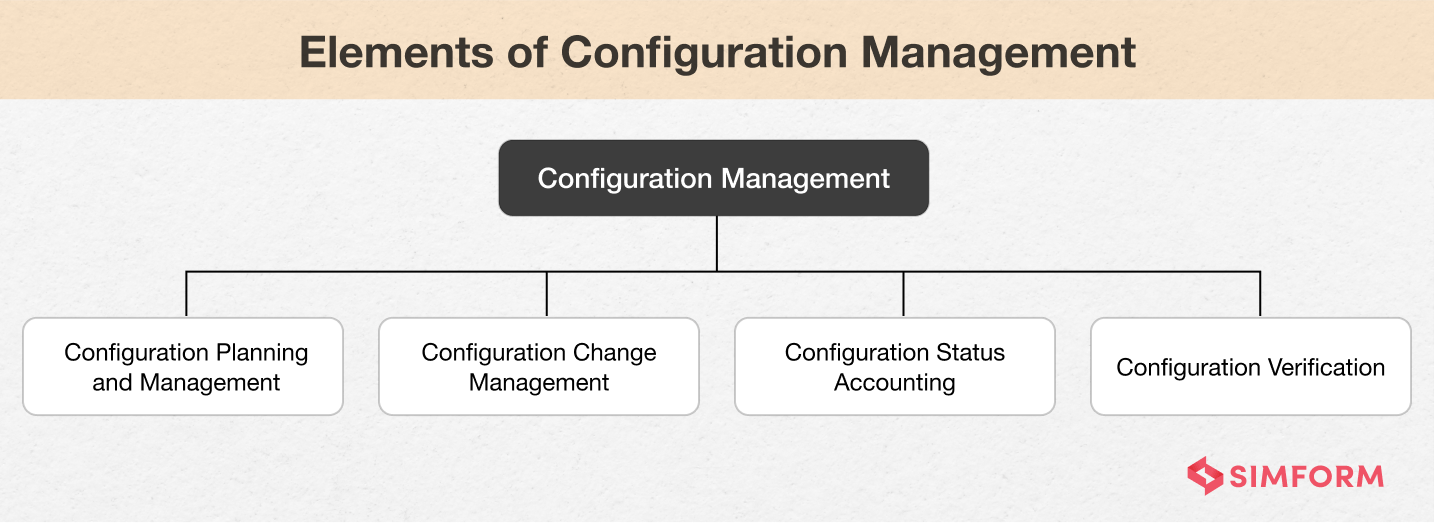
Configuration and change management are two of the most critical aspects from the operations perspective. It involves automation, monitoring, maintenance, control, and system configuration throughout servers, networks, and applications. Configuration of all processes according to the DevOps methodology helps software developers and operation managers to improve the deployment and delivery process. Here are some of the most popular configuration management tools utilized in the industry:
- Chef: Chef is a configuration management tool used by DevOps-oriented companies for automating infrastructure provisioning. It also helps in server management.
- Ansible: Ansible is an open-source, software provisioning, and configuration management tool that enables infrastructure as a code mechanism.
- Puppet: Puppet is a software configuration management tool used for IT automation. Puppet is leveraged on platforms such as IBM mainframes, Cisco switches, and Mac OS.
Continuous integration
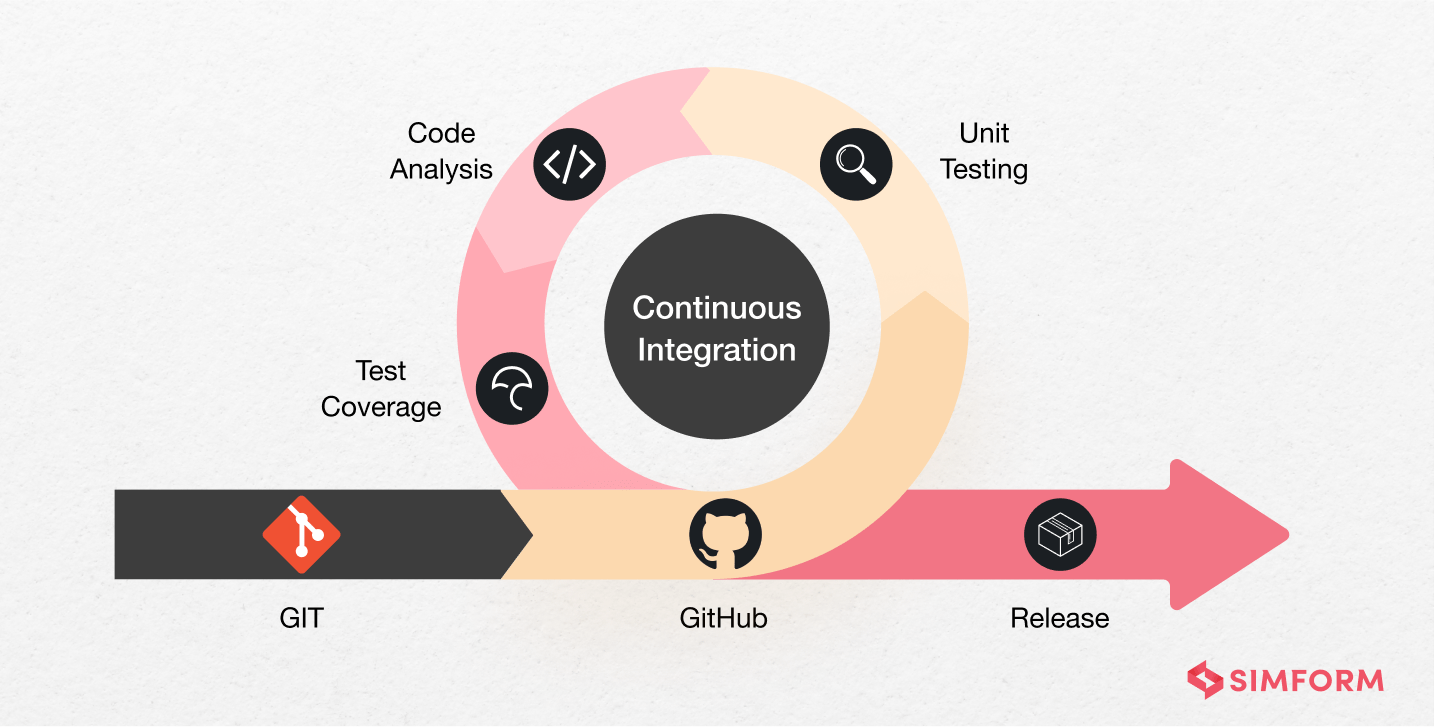
Continuous integration allows developers to merge code changes and update the codebase into the master and shared repository. The master repository automatically builds and runs the application so that developers can access various bugs and errors. As a result, developers can repair those errors to enhance the software quality and minimize the time required for releasing or integrating the next version seamlessly. Here are some of the continuous integration tools used in the industry:
- Jenkins: Jenkins is an open-source automated server written in Java that allows developers to orchestrate the practices of continuous integration automatedly.
- Gitlab: GitLab is one of the most popular automation tools that focuses on continuous integration for software development. It assists developers in a faster release.
- Bamboo: Bamboo is a continuous integration server that automates the management of software application development and also helps create a delivery pipeline.
FIH, the international governing body for field hockey needed to launch the most powerful web presence before Hockey World Cup 2018 was held in India. Improving their online web experience was the biggest challenge and for that purpose, the organization required website redesign. During this transformation, Simform adopted DevOps engineering practices of continuous integration using Jenkins and achieve ensure zero downtime and ensure quality delivery while increasing the efficiency of the CI/CD process.
Continuous deployment and delivery
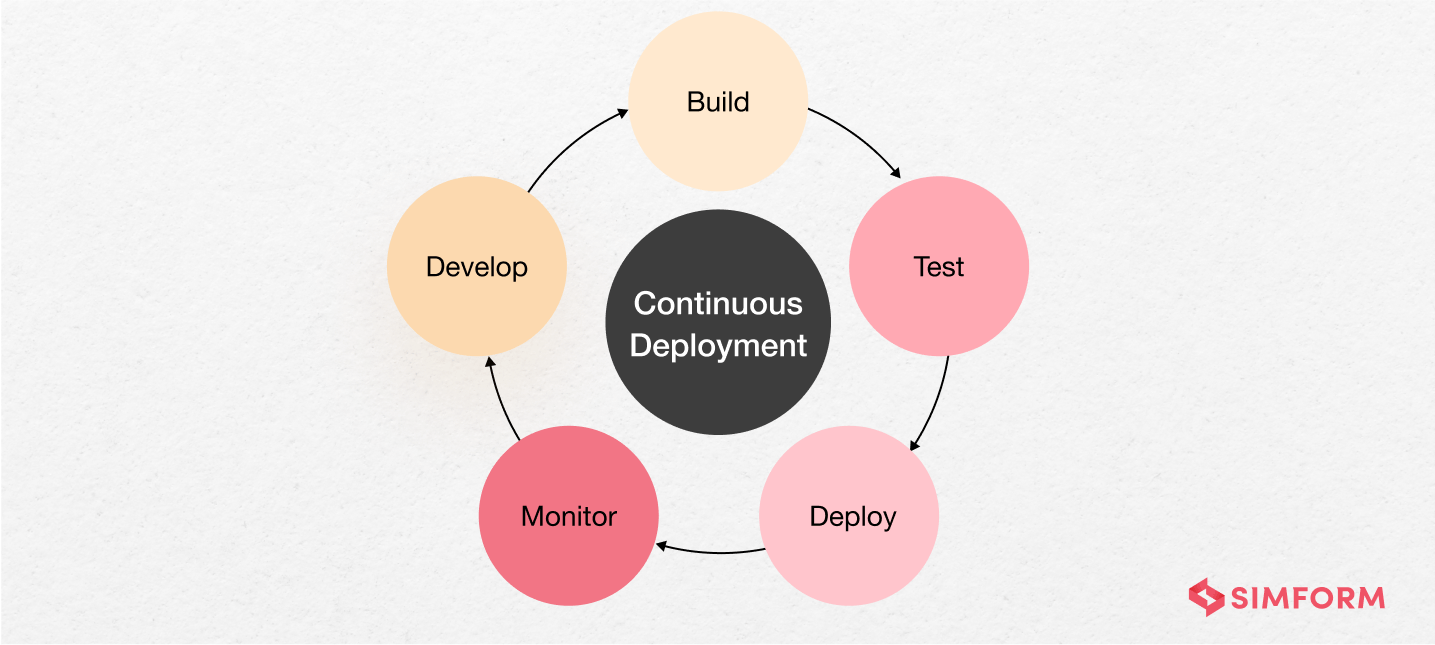
Continuous deployment allows the DevOps engineers to automate the entire process from the code commit to production. There is an automation set between the development and delivery stage; the code automatically updates after passing all the test cases in the QA (Quality Assurance) environments. The customers will receive the updated version of the application as the improvements are made.
Here are some of the popular tools for continuous deployment:
- AWS CodeDeploy: AWS CodeDeploy is a fully managed deployment service from AWS that focuses on the error-free continuous deployment of your applications.
- Octopus Deploy: Octopus Deploy is an automated deployment server that makes it easier to deploy applications written in Java, ASP.NET, Node.js, etc.
- DeployBot: DeployBot can be used to build and deploy the code by following one consistent process. The tool provides support for manual and automated deployment.
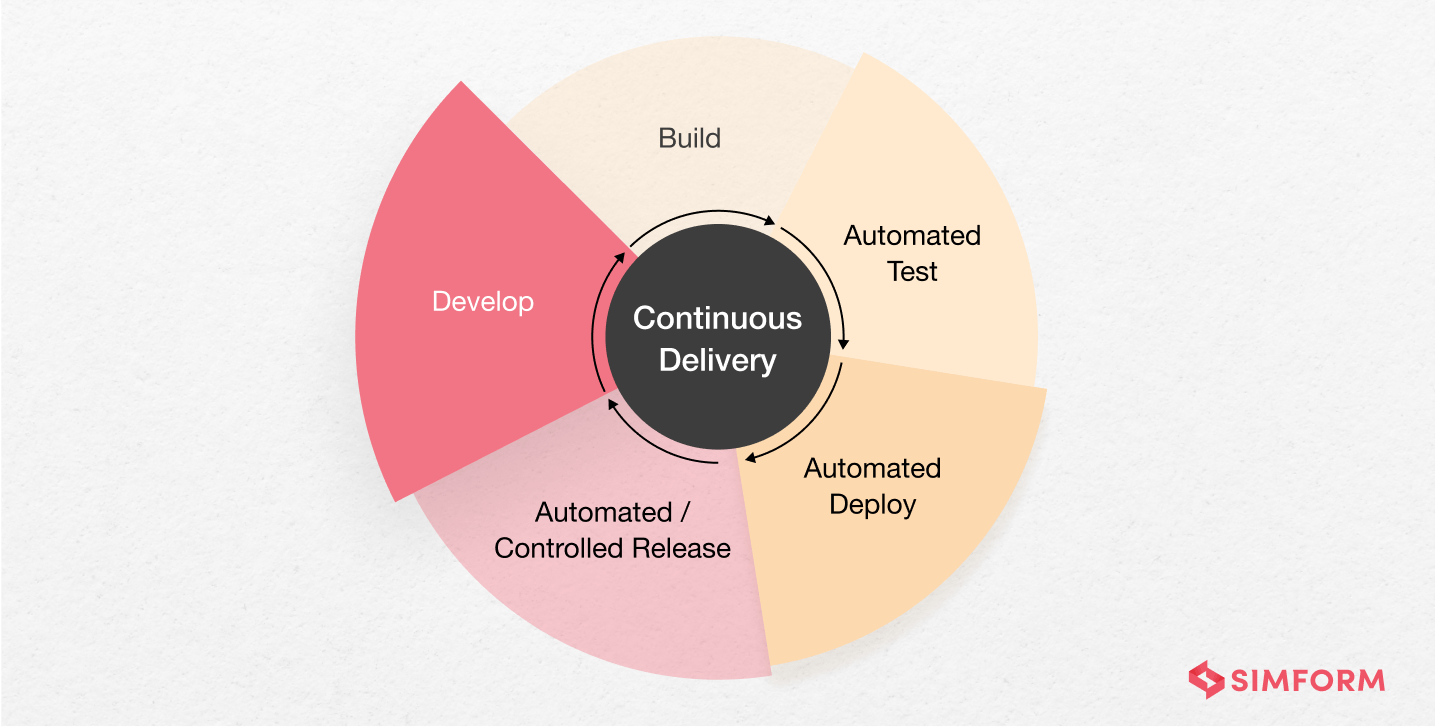
Much effort and time are utilized while building and releasing enterprise-level software. However, single releases are recipes for poor quality and performance. Instead, orchestrating continuous delivery of business applications is the new-age strategy that focuses on constant improvement and continuous integration to ensure the delivery of high-quality software.
Tommy Tynjä, the Senior Engineering Manager at Spotify gives a good insight on how one can get success with continuous delivery. He says, “To successfully implement continuous delivery, you need to change the culture of how an entire organization views software development efforts.”
The most popular tools for continuous delivery are:
- Buddy: Buddy is a smart CI/CD tool designed for lowering the entry threshold to DevOps. It uses delivery pipelines to build, test and deploy software.
- CircleCI: Circle CI is a CI/CD tool that provides support for rapid software development and deployment. It automates the user pipeline to ensure faster delivery.
- TeamCity: TeamCity is Jetbrains’s CI/CD tool that helps you build, deploy, and deliver various types of software projects. It runs in Java and can integrate with Visual Studio.
Continuous testing
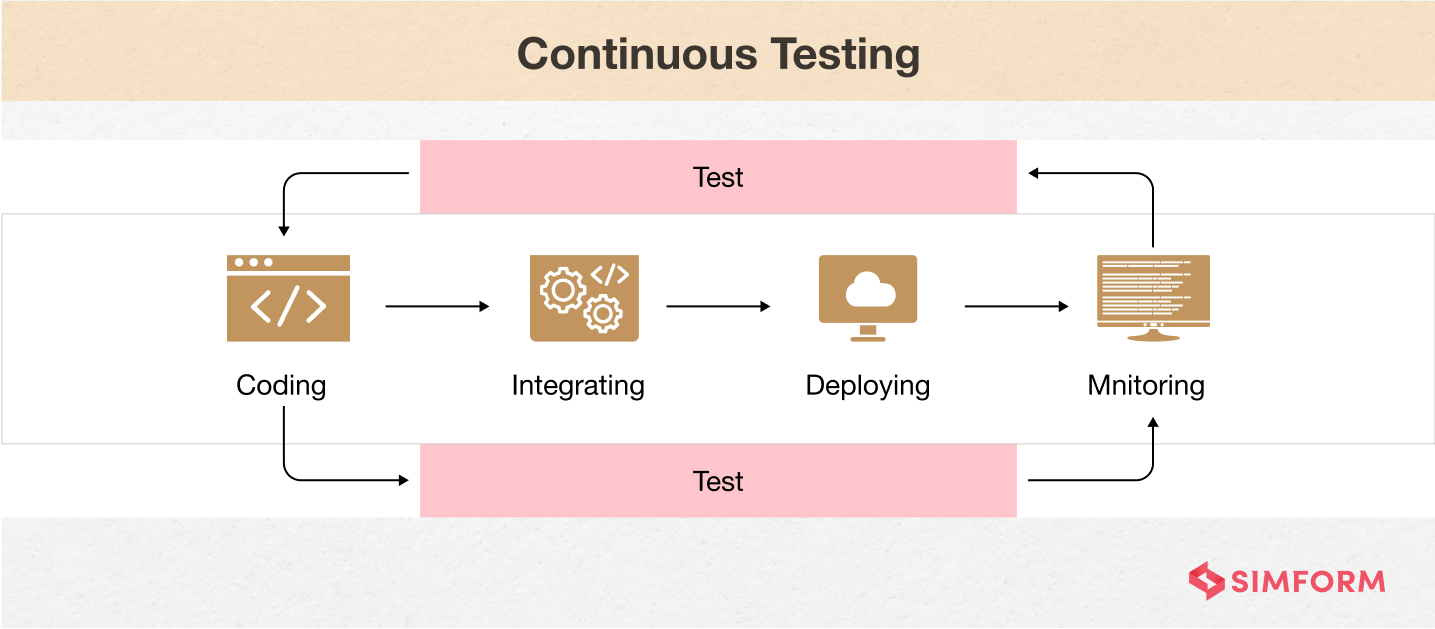
Testing is another aspect that most people don’t give importance to in a traditional software development lifecycle. However, when you’re working towards DevOps adoption, you need to follow the practice of automation and continuous testing. It will help developers identify and resolve the error at the earliest stage before the software goes into production. Unlike manual testing, automated testing is more reliable and error-free. Here are some tools for continuous testing:
- Selenium: Selenium is one of the most popular tools used for cross-platform automated testing. It focuses on website and web application testing.
- Applause: Applause provides authentic, real-time feedback on digital experience quality to release high-quality products at a faster rate.
- Blazemeter: Blazemeter is an open-source, enterprise-ready continuous testing platform that provides support for performance testing, functional testing, and load testing.
Fill in Rx is a pharmacy staffing solution developed by Simform. The company wanted to build a marketplace that can connect pharmacies and pharmacists. To accomplish this, the engineering team at Simform adopted agile development methodology and built the platform in monthly sprints. Now, to ensure the delivery of a robust and high-quality build, we adopted a continuous testing approach and leveraged Applause. With the help of this tool, we achieved superior quality and user experience before going live. The focus on testing the app in the real world with real users helped us to achieve better performance.
Continuous monitoring
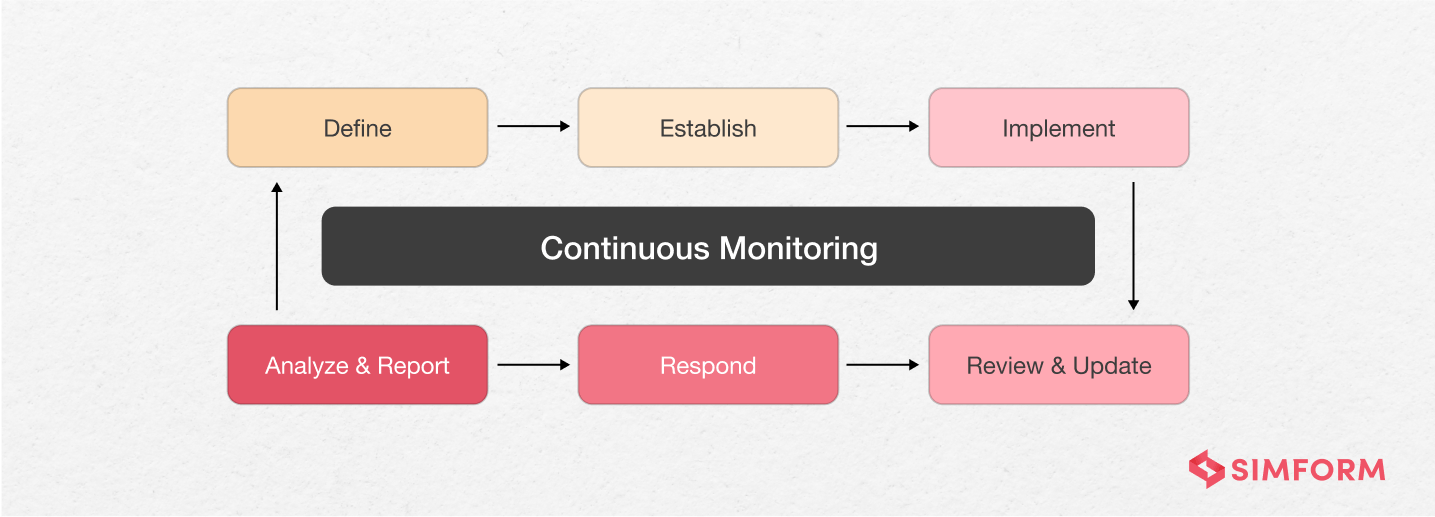
Continuous monitoring is the standard practice of using procedures, techniques, and tools that help measure and track the processes of each development and operations-related lifecycle phase. This approach will help you ensure the application’s performance, efficiency, and reliability of the software as it moves from the development to the production stage. Here are some of the popular tools for continuous monitoring:
- AWS CloudWatch: It collects, accesses, and correlates data on a single platform from your AWS resources to monitor the performance of an application.
- Akamai mPulse: It’s a real-time monitoring tool that allows DevOps teams to collect and analyze the experience and behavior data of users who visit their websites.
- Dynatrace: It provides a single platform with the ability to monitor the entire DevOps technology and environment stack with utmost ease.
TransTMS is a logistics and transportation management software solution developed by Simform. It aims to provide an end-to-end freight brokerage system that automates day-to-day functions of logistics in the North America and Canada region. As the whole new system was being built to automate logistic functions, keeping an eye on its performance was paramount. We used AWS CloudWatch which allowed us to keep track of the system’s operational health. Also, we could set triggers to take a particular action or troubleshoot issues so that the system runs smoothly.
Conclusion
Enterprise DevOps implementation does not have to be complicated if all the necessary steps are taken care of along with the right approach. DevOps is considerably new to most companies despite its long existence. It has proved to be highly effective in helping organizations to innovate and bring new and improved procedures, capabilities, technologies, and tools into practice.
Now, continuously re-inventing the wheel in terms of DevOps can be pretty challenging for any enterprise with many business decisions to consider. That’s where Simform can be your trusted partner. We have the capability and expertise to provide high-end DevOps consulting services to your enterprise worldwide. So connect with us and avail our expert DevOps practitioners to build, test, and deploy faster by accelerating your development pipeline.

